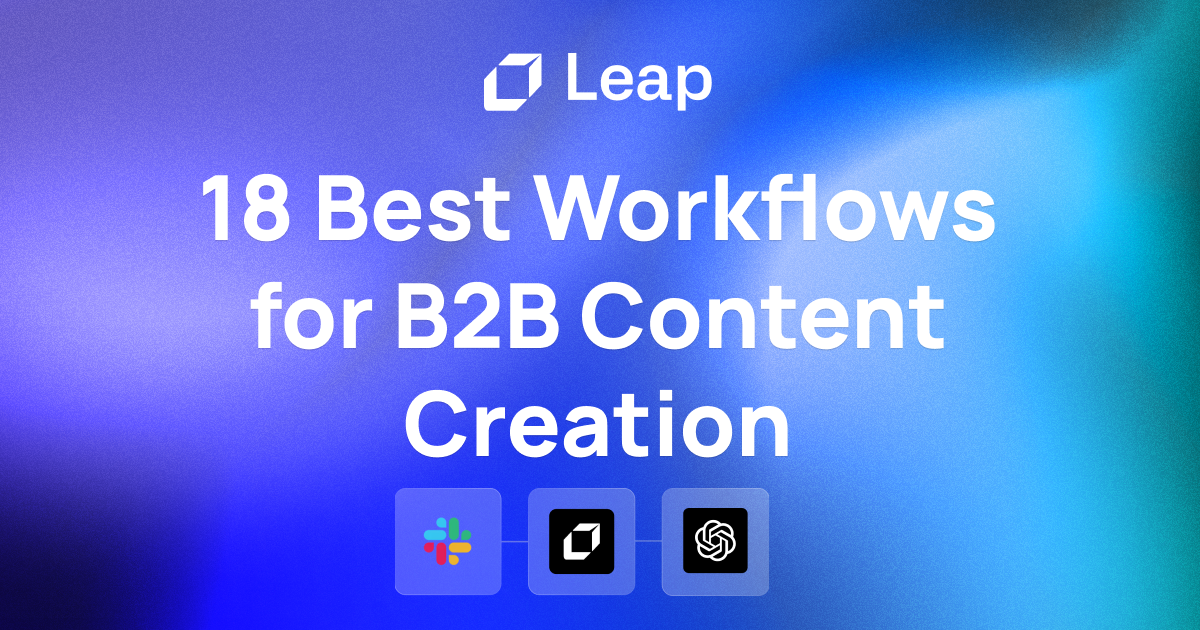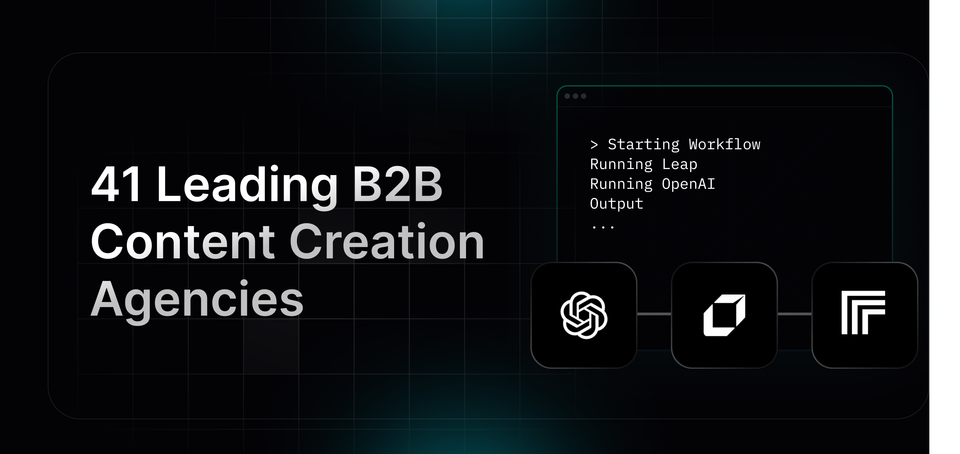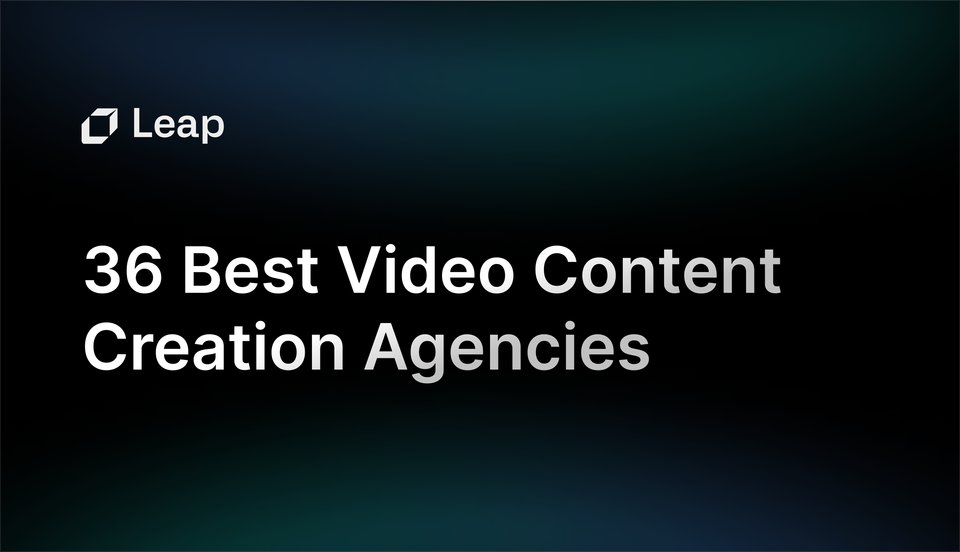18 Best Workflows for B2B Content Creation & Free AI No Code Tool
Unlock business success with B2B content creation. Elevate your brand, engage audiences, and drive results with compelling corporate storytelling

Are you struggling to create engaging and effective B2B content? Look no further. In this blog, we'll dive into the world of B2B content creation, exploring the strategies, tips, and tricks that will take your content to the next level. From understanding your target audience and crafting compelling headlines, to incorporating SEO best practices and utilizing various content formats, we'll cover it all. So, whether you're a seasoned content creator or just starting out, join us on this journey as we unravel the secrets of B2B content creation and unlock the potential of your brand. Get ready to transform your Content Creation game!

What Is The Secret Behind B2B Content Creation?

In business-to-business (B2B) marketing, creating captivating and informative content is crucial. B2B content creation involves developing and sharing valuable information, such as articles, blog posts, whitepapers, videos, and infographics, that cater specifically to other businesses rather than individual consumers. The secret behind successful B2B content creation lies in the ability to engage, educate, and build trust with your target audience. Let's explore the essential components of B2B content creation that will unlock the power of your marketing efforts.
1. Understanding Your Target Audience
To create compelling B2B content, you must have a deep understanding of your target audience. Research your customers' pain points, challenges, goals, and preferences. By understanding their needs and desires, you can tailor your content to provide valuable solutions and insights. Identify key decision-makers within the businesses you are targeting to ensure your content speaks directly to their concerns.
2. Creating Valuable and Educational Content
B2B content creation revolves around providing valuable and educational information that helps your audience solve their problems or achieve their goals. By offering insights, industry trends, best practices, and actionable advice, you position yourself as an expert and trusted advisor. Whether it's in the form of in-depth whitepapers, case studies, or informative blog posts, your content should provide genuine value to your audience.
3. Telling Compelling Stories
Humans are wired to respond to stories. Incorporating storytelling into your B2B content creation can capture your audience's attention, evoke emotions, and increase engagement.
Craft narratives that demonstrate how your product or service has positively impacted other businesses, showcasing measurable results and successful partnerships. By weaving a compelling story, you can create an emotional connection with your audience, making your content more memorable and impactful.
4. Leveraging Different Formats and Channels
B2B content creation is not limited to written articles alone. Explore different formats such as videos, webinars, podcasts, and infographics to cater to diverse learning preferences. A mix of formats will keep your audience engaged and allow you to deliver information in different ways.
Consider distributing your content across various channels, including social media platforms, industry forums, email newsletters, and collaborations with industry influencers. This multi-channel approach increases your reach and enables you to connect with a wider audience.
5. Optimizing for Search Engines
While creating valuable content is vital, it is equally important to ensure that your target audience can find it. Incorporate search engine optimization (SEO) strategies into your B2B content creation to improve your visibility in search engine results.
Conduct keyword research to identify relevant terms and phrases that your audience is searching for. Incorporate these keywords naturally into your content, including titles, headings, and meta descriptions. Strategic use of keywords will increase the visibility of your content, driving more organic traffic to your website.
6. Measuring and Analyzing Performance
The secret to continuous improvement in B2B content creation lies in measuring and analyzing the performance of your content. Utilize analytics tools to track metrics such as website traffic, time spent on page, bounce rates, and conversion rates. Analyze which types of content, formats, and topics perform best, and use these insights to refine your content strategy. Experiment with A/B testing to optimize your content and achieve better results over time.
B2B content creation is an art that combines deep audience understanding, valuable insights, storytelling, and optimization strategies. By creating content that educates, engages, and builds trust with your audience, you can unlock the power of B2B marketing. With a well-crafted content strategy, you can position yourself as a thought leader, attract high-quality leads, and drive business growth.

Related Reading
- Artificial Intelligence Content Creation
- Video Content Creation
- Facebook Content Creation
- Content Creation Process
- Content Creation Examples
- Content Creation Strategy
- Content Creation Ideas
- Social Media Content Creation
- Ai Content Creation
18 Best Workflows for B2B Content Creation

1. Research and Planning
Before starting any B2B content creation project, it is crucial to conduct thorough research and planning. This includes identifying target audiences, understanding their needs and pain points, analyzing competitors' content, and developing a content strategy. By doing so, businesses can ensure their content is relevant, valuable, and tailored to their target audience.
2. Ideation and Brainstorming
The ideation and brainstorming phase involves generating creative ideas for B2B content. This can be done through collaborative sessions with team members, client input, or by leveraging tools like mind maps or idea boards. The goal is to come up with unique angles, topics, and formats that will engage the target audience and differentiate the content from competitors.
3. Content Calendar Creation
A content calendar serves as a roadmap for B2B content creation. It helps businesses organize their content production, plan ahead, and ensure a consistent flow of content. The calendar should include key dates, topics, assigned team members, and deadlines. Tools such as Google Calendar or project management software can be used to create and share content calendars with the team.
4. Writing and Editing
The writing and editing phase involves transforming ideas into well-crafted B2B content. It is important to use a clear and concise writing style that resonates with the target audience. The content should be proofread and edited for grammar, spelling, and clarity. Collaborative editing tools like Google Docs or Grammarly can be used to streamline the review process and ensure high-quality content.
5. Visual Content Creation
Visual content plays a crucial role in B2B content creation. Businesses can create eye-catching visuals such as infographics, charts, or videos to complement their written content. Tools like Canva, Piktochart, or Adobe Creative Suite can be utilized to create professional-looking visuals that enhance the overall impact of the content.
6. SEO Optimization
To maximize the visibility and reach of B2B content, SEO optimization is essential. This involves conducting keyword research, optimizing meta tags, headings, and URLs, and ensuring the content is structured in a way that search engines can easily understand. Tools like Google Keyword Planner or Moz can assist in identifying relevant keywords and optimizing content for search engines.
7. Content Distribution and Promotion
Even the best B2B content will not have an impact if it is not effectively distributed and promoted. Businesses should leverage various channels such as social media, email marketing, influencer outreach, or guest blogging to increase the reach and visibility of their content. Engaging with industry-specific communities and participating in relevant forums can help generate buzz and attract targeted audiences.
8. Content Repurposing
Reusing existing content in different formats is an efficient way to extend the lifespan and reach of B2B content. Businesses can repurpose blog posts into videos, create slide decks from whitepapers, or convert webinars into podcasts. This not only saves time and resources but also allows businesses to cater to different content preferences and engage a wider audience.
9. User-Generated Content
Incorporating user-generated content (UGC) into B2B content creation can add authenticity and credibility. Encouraging customers to share their experiences, testimonials, or case studies can create a sense of community and build trust. UGC can be collected through surveys, social media contests, or by featuring customer stories on the company's website or blog.
10. Collaboration with Subject Matter Experts
Collaborating with subject matter experts (SMEs) can add depth and expertise to B2B content. SMEs can contribute by providing insights, contributing to guest blog posts or interviews, or reviewing and endorsing the content. This collaboration not only enhances the quality of the content but also helps establish the business as a thought leader in the industry.
11. Monitoring and Analytics
Monitoring and analyzing the performance of B2B content is crucial for measuring success and making data-driven decisions. Businesses should track metrics such as website traffic, engagement, conversion rates, and social media shares. Tools like Google Analytics or social media analytics platforms can provide valuable insights into content performance and audience behavior.
12. A/B Testing
To optimize B2B content for maximum effectiveness, A/B testing can be employed. This involves creating variations of the content and testing them against each other to determine which version performs better. By testing different headlines, visuals, or call-to-action, businesses can fine-tune their content to resonate with their target audience and drive desired outcomes.
13. Thought Leadership Content
Building thought leadership through B2B content is an effective way to establish credibility, attract leads, and differentiate from competitors. Thought leadership content can include in-depth industry analysis, original research, or opinion pieces on trending topics. By positioning the business as an authoritative source, businesses can attract a loyal following and generate valuable leads.
14. Content Amplification through Influencers
Leveraging influencers in the industry can amplify the reach and impact of B2B content. Businesses can collaborate with influencers to co-create content, have them share or endorse the content on their platforms, or invite them to participate in webinars or podcasts. This helps tap into the influencers' established audience and gain credibility among their followers.
15. Content Localization
For businesses operating in global markets, content localization is essential. This involves adapting the content to suit the cultural and linguistic preferences of different regions. Businesses can employ native translators or localization experts to ensure the content resonates with the target audience and overcomes language and cultural barriers.
16. Customer Journey Mapping
Understanding the customer journey is vital for creating B2B content that meets the needs and expectations of potential customers at each stage. By mapping out the customer journey, businesses can identify touchpoints where content can be effectively utilized to educate, engage, and convert prospects. This helps deliver personalized content that addresses specific pain points and drives conversions.
17. Customer Feedback Integration
Incorporating customer feedback into B2B content creation helps align content with customer needs and preferences. Businesses can gather feedback through surveys, social media listening, or customer support interactions. By understanding customers' challenges, pain points, and preferences, businesses can create content that resonates and provides value.
18. Continuous Improvement and Optimization
B2B content creation should be an iterative process that continuously improves and optimizes content based on feedback and data. By monitoring performance metrics, analyzing customer feedback, and testing new ideas, businesses can identify areas for improvement and refine content strategies. This approach ensures that B2B content remains relevant, engaging, and impactful in an ever-evolving digital landscape.
How To Make Your Content Stand Out

In today's digital age, businesses face the challenge of standing out in the crowded landscape of B2B content creation. With countless companies vying for attention, it can be difficult to capture the interest of your target audience. With the right strategies and tactics, you can create content that not only grabs attention but also drives engagement and builds trust. Here are some key ways to make your B2B content stand out from the crowd.
1. Define your audience and craft tailored content
One of the most crucial steps in creating standout B2B content is understanding your target audience. By defining their needs, pain points, and preferences, you can tailor your content to resonate with them. Take the time to research your audience and create buyer personas that represent your ideal customers. This will help you create content that speaks directly to their challenges and offers solutions.
2. Create compelling headlines and introductions
In the vast sea of B2B content, a strong headline and introduction are essential for grabbing attention and enticing readers to delve deeper into your content. Craft headlines that are concise, intriguing, and relevant to your audience's interests. Use powerful words and evoke curiosity to spark their interest. Similarly, your introduction should be engaging and compelling, setting the tone for the rest of the content and drawing readers in.
3. Focus on quality over quantity
While it may be tempting to churn out a large volume of content, quality should always take precedence over quantity. In the B2B space, your audience is looking for valuable, informative, and actionable content that helps them solve their challenges. Invest time in thorough research, fact-checking, and editing to ensure that your content is well-researched, accurate, and provides genuine value to your readers. This will not only position your brand as a trusted authority but also encourage your audience to share your content with others.
4. Leverage visual elements
In a world where attention spans are shrinking, incorporating visual elements into your B2B content can make a significant impact. Visuals such as images, infographics, videos, and charts not only break up the text but also make your content more engaging and memorable. They can help convey complex information in a digestible format and increase the overall appeal of your content. Optimizing your visuals for search engines can improve your content's visibility and reach.
5. Incorporate storytelling techniques
Storytelling is a powerful tool for captivating your audience and making your B2B content stand out. By weaving narratives into your content, you can connect with your audience on an emotional level and create a memorable experience. Use anecdotes, case studies, or customer success stories to demonstrate how your product or service has made a positive impact. By humanizing your content, you can build trust and establish a deeper connection with your audience.
6. Utilize interactive content formats
To stand out in the B2B content space, consider utilizing interactive content formats such as quizzes, assessments, calculators, or interactive infographics. These formats not only engage your audience but also provide personalized experiences. By tailoring the content to the specific needs and interests of each user, you can enhance their engagement and make your content more memorable. Interactive content also encourages social sharing and can generate valuable leads for your business.
7. Optimize for search engines and distribution channels
Even the most exceptional B2B content will be ineffective if it doesn't reach the right audience. To maximize the visibility of your content, optimize it for search engines and distribution channels. Conduct keyword research to identify relevant search terms and incorporate them strategically into your content. Optimize your meta descriptions, headings, and image alt tags to improve your content's search engine ranking. Leverage social media, email marketing, and other distribution channels to reach your target audience.
In B2B content creation, making your content stand out requires a thoughtful approach. By understanding your audience, crafting tailored content, creating compelling headlines, focusing on quality, leveraging visuals, incorporating storytelling, utilizing interactive formats, and optimizing for search engines, you can rise above the noise and create content that resonates with your target audience.
The Importance of Storytelling In B2B Content Creation

Storytelling has emerged as a powerful tool in the realm of B2B content creation, adding depth and resonance to the otherwise dry and technical subject matter. By weaving narratives into their messaging, B2B companies can captivate their audience, establish emotional connections, and ultimately drive engagement and conversions.
1. Engaging the Audience
In the world of B2B, it can be challenging to capture the attention of busy professionals who are bombarded with a constant stream of information. This is where storytelling comes in. By presenting information in the form of a story, businesses can create a compelling narrative that grabs the audience's attention and keeps them engaged throughout the content.
For example, instead of a straightforward case study that simply outlines the problem, solution, and outcome, a B2B company could craft a narrative that follows a fictional character facing a similar challenge. By following this character's journey, the audience becomes emotionally invested and more likely to remember the key points being made.
2. Building Trust and Credibility
In the B2B world, trust is crucial. Companies need to establish themselves as knowledgeable and reliable partners in order to win over potential clients. Storytelling can play a vital role in building trust and credibility.
By sharing stories of successful collaborations, satisfied customers, or industry expertise, B2B companies can showcase their track record and establish themselves as authorities in their field. These stories provide tangible evidence of their capabilities and create a sense of confidence in the minds of potential clients.
3. Simplifying Complex Concepts
B2B content often deals with complex and technical concepts that can be difficult for the average reader to grasp. Storytelling can simplify these concepts by breaking them down into relatable and understandable narratives.
For instance, if a B2B company offers a software solution, they could use storytelling to explain how it works by following the journey of a character struggling with a particular problem. By illustrating the solution through a story, the company can make the complex seem more approachable and digestible for their audience.
4. Evoking Emotions and Connecting on a Human Level
While B2B transactions are typically driven by logic and rational decision-making, it's important to remember that businesses are composed of people. Storytelling helps to tap into the emotional side of decision-making and create a connection on a human level.
By sharing stories that evoke emotions such as empathy, inspiration, or even humor, B2B companies can forge a stronger bond with their audience. This emotional connection can lead to increased brand loyalty and long-term relationships with clients and partners.
5. Differentiating from Competitors
In a crowded marketplace, B2B companies need to find ways to stand out from their competitors. Storytelling can be a powerful tool in this regard, helping businesses create a unique and memorable brand identity.
By crafting narratives that highlight their values, company culture, or the journey of their founders, B2B companies can set themselves apart and create a distinct personality that resonates with their target audience. This differentiation can give them a competitive edge and make them more memorable in the minds of potential clients.
Storytelling plays a vital role in B2B content creation. By engaging the audience, building trust and credibility, simplifying complex concepts, evoking emotions, and differentiating from competitors, storytelling can transform B2B content from dry and technical to captivating and impactful. By harnessing the power of storytelling, B2B companies can create content that not only educates but also entertains, leaving a lasting impression on their audience.
Examples of Successful B2B Content Campaigns

The Power of Storytelling: Cisco's "The Network"
One example of a successful B2B content campaign is Cisco's "The Network." This campaign effectively used storytelling to engage and connect with its audience. "The Network" was a series of short films that showcased the impact of Cisco's technology on various industries and individuals. Each film followed a narrative structure, highlighting real-life success stories and showing how Cisco's solutions helped businesses overcome challenges and achieve their goals.
By using storytelling, Cisco was able to humanize its technology and show the tangible benefits it brings to businesses. This approach allowed potential customers to see themselves in the stories and understand the value Cisco could provide. The campaign was not focused on selling products directly but rather on building a relationship with the audience and establishing Cisco as a trusted partner.
Thought Leadership and Expertise: HubSpot's Blog
HubSpot's blog is another example of successful B2B content creation. The blog provides valuable and educational content on various topics related to marketing, sales, and customer service. It positions HubSpot as a thought leader in the industry and helps build trust and credibility among its target audience.
The effectiveness of HubSpot's blog lies in its ability to address the pain points and challenges faced by its target audience. The content is well-researched, practical, and actionable, providing readers with the information they need to improve their business strategies. By consistently delivering high-quality content, HubSpot has been able to attract a large and engaged audience, ultimately driving leads and conversions.
Interactive Content and Personalization: Salesforce's "State of Sales"
Salesforce's "State of Sales" report is a successful example of using interactive content and personalization in B2B content creation. This annual report provides insights and trends in the sales industry, helping sales professionals stay up to date with the latest developments.
Engaging Personalization
What makes this campaign effective is its interactive format. Readers can customize the report based on their role, industry, and region, creating a personalized experience. This level of personalization not only increases engagement but also makes the content more relevant and valuable to the individual reader.
The report includes interactive elements such as quizzes and assessments, allowing readers to evaluate their own sales practices and compare them to industry benchmarks. This interactive approach not only keeps readers engaged but also positions Salesforce as a trusted advisor and resource for sales professionals.
Engaging Visual Content: Mailchimp's "Did You Mean Mailchimp?"
Mailchimp's "Did You Mean Mailchimp?" campaign is a great example of using engaging visual content in B2B marketing. The campaign consisted of a series of short animated videos that humorously addressed common misspellings and mispronunciations of the company's name.
By using fun and visually appealing animations, Mailchimp was able to capture the attention of its target audience and create a memorable brand experience. The campaign not only increased brand awareness but also showcased Mailchimp's personality and creativity. This approach helped differentiate Mailchimp from its competitors and positioned the company as a fun and approachable option in the B2B space.
Successful B2B content campaigns utilize various strategies to engage and connect with their target audience. Whether it's through storytelling, thought leadership, interactive content, or engaging visuals, these campaigns focus on providing value, building trust, and establishing a strong brand presence. By understanding the needs and challenges of their audience and delivering content that addresses those pain points, B2B companies can create effective content campaigns that drive results.
Related Reading
- Ugc Content Creation
- Content Marketing Content Creation
- Content Creation Seo
- Content Marketing E Commerce
- Content Creation Workflow
- Ai Social Media Content Creation
- Content Creation Tips
- Content Creation For Instagram
- Ai Video Content Creation
- How To Use Chatgpt For Content Creation
- Content Creation Ideas For Youtube
- Content Creation Ideas For Tiktok
- Content Creation Ideas For Instagram
Create Game Changing Automations Today With Leap’s AI Workflows
As a B2B content creator, you understand the importance of efficiency and productivity in your day-to-day work. That's where Leap comes in – an AI-powered automation tool designed to take your content creation process to new heights.
With Leap's AI Workflows, you can streamline your content creation process and automate repetitive tasks, allowing you to focus on what truly matters – crafting compelling and engaging B2B content. Whether you're summarizing documents, translating voice recordings, transcribing AI calls, generating AI avatars and assets, or automating SEO optimization, Leap Workflows has got you covered.
Summarize Documents in a Snap
As a B2B content creator, you often find yourself sifting through mountains of information to extract the key insights that will shape your content. With Leap's AI document summarization capabilities, you can save time and effort by automating the summarization process.
Simply input your document, and Leap will generate a concise summary that captures the essence of the text. This feature not only helps you speed up your research process but also ensures that you never miss any critical information.
Effortless Voice Translation
In today's globalized business landscape, effective communication with clients and partners from different linguistic backgrounds is crucial. Leap's AI-powered voice translation takes the hassle out of language barriers.
Simply record your voice message, and Leap will instantly translate it into the desired language. This powerful tool enables you to communicate seamlessly with clients and prospects from around the world, opening up a world of opportunities for your B2B content creation.
AI Call Transcription for Enhanced Productivity
As a B2B content creator, you may find yourself juggling multiple projects and engaging in countless conference calls. Keeping track of all the important details discussed during these calls can be a daunting task. That's where Leap's AI call transcription comes in.
By automatically transcribing your calls, Leap ensures that you capture every valuable insight and idea shared during your conversations. With this feature, you can focus on actively engaging in the conversation, knowing that Leap has got your back when it comes to documentation.
AI Avatar and Asset Generation Made Easy
Visual content is becoming increasingly important in B2B marketing. Creating eye-catching visuals can be time-consuming and costly. Leap's AI avatar and asset generation capabilities simplify this process.
With just a few clicks, you can generate high-quality avatars and assets that align with your brand identity. Whether you need images for your blog posts, social media campaigns, or website, Leap has the tools to help you create visually stunning content that resonates with your target audience.
Automate SEO Optimization for Enhanced Visibility
Search engine optimization (SEO) is vital for ensuring your B2B content reaches the right audience. Leap's AI-powered SEO automation takes the guesswork out of optimizing your content for search engines.
By analyzing keywords, competitors, and market trends, Leap's AI algorithms provide you with actionable insights to boost your search engine rankings. This feature helps you stay ahead of the curve and ensures that your B2B content gains the visibility it deserves.
Try Leap's AI Workflows for Free Today
Ready to take your B2B content creation to the next level? Try Leap's AI Workflows tool for free today. With its seamless integration with leading AI platforms like OpenAI and Microsoft, you can leverage the power of AI to supercharge your existing tools. From automated document summarization to voice translation and AI call transcription, Leap has the capabilities you need to streamline your content creation process and enhance your productivity.
Don't miss out on the endless opportunities for automation – start using Leap Workflows today.
Related Reading
- Content Creation Tools
- Content Creation Agency
- Content Creation Software
- Automated Content Creation
- Ai Tools For Content Creation
- Social Media Content Creation Services
- Social Media Content Creation Agency
- Best Content Creation Apps
- Seo Content Creation Services
- Digital Content Creation Tools
- Social Media Content Creation Tools
- Video Content Creation Agency
- B2B Content Creation Agency
- Tiktok Content Creation Agency
- Content Creation Marketing Agency




